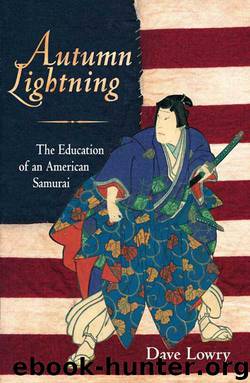Autumn Lightning: The Education of an American Samurai by Lowry Dave

Author:Lowry, Dave [Lowry, Dave]
Language: eng
Format: mobi
Publisher: Shambhala Publications
Published: 2013-12-03T05:00:00+00:00
Wooden statue of Yagyu Munenori (1571–1645), founder of the Yagyu Shinkage ryu.
1. Manju are pastries filled with sweetened bean paste. They are a popular snack for children and a common votive offering at temples.
8.
The Shogun’s Master
In April of 1565, the fourth month of the seventh year of Eiroku, when the fuzzy buds on the maples of Yagyu village had swelled to the size of a badger’s ear, Kamiizumi Nobutsuna presented his disciple Yagyu Muneyoshi with a certificate of proficiency in what, according to the characters brushed on the fine mulberry parchment, was the Shinkage ryu of kenjutsu.1 Although his other two students, Jingo Muneharu and Hikida Bungoro were under Nobutsuna’s tutelage longer than Muneyoshi, Nobutsuna was confident that in the swordsman from Yagyu were the qualities of a warrior who would carry on and perhaps even improve the Shinkage ryu.2
The opinions and beliefs of contemporary bugeisha notwithstanding, the secrets of both the old and new versions of the Kage style of the martial arts were not the results of any supernatural divination, even though for many generations to come, once they had been established as the ablest practitioners of the ryu, the men of Yagyu were to be linked with dealings with the mountain tengu (goblin) spirits. Instead, the Kage and Shinkage ryu’s foundation was built on a single guiding principle, which Muneyoshi grasped so completely that there was no question in his master’s mind that this student would be granted the title of headmaster of the ryu and initiated into its highest teachings. Drawn from sources in Asia so ancient that no one could possibly have traced their roots, the principle was profound, yet of perfect simplicity. According to the principle, if a man’s mind is crowded with the ten thousand incidentals that threaten to hurry their way into our consciousness every moment of life, then inevitably he will find himself concentrating on one or another of them, and at that moment his thoughts—and actions—are stopped. However, if he is able to diffuse his consciousness, allowing every bit of input to pass in without focusing on any, then his mind flows with a constancy and celerity that makes his motions utterly spontaneous; appropriate. Whether he is drinking a cup of tea or cleaving an enemy’s head in half with a sword, he will be in accord with the movements of the universe itself. Of course, when a swordsman kept himself so receptive, his mind calmly centered, then he revealed nothing of his mind to an opponent. His strategy was kept hidden, in the shade, so to speak. It was this philosophy that gave the ryu its name and its exponents such awesome reputations as bugeisha.
By the customs of lineage and inheritance within the Japanese martial ryu, Muneyoshi’s acceptance of the certificate from Nobutsuna made him the successor to the Shinkage ryu’s leadership. Under more normal circumstances, the position would have meant that Muneyoshi could have ascended to an honored place as the master teacher of the school, instructing at the dojo at Koyagyu.
Download
This site does not store any files on its server. We only index and link to content provided by other sites. Please contact the content providers to delete copyright contents if any and email us, we'll remove relevant links or contents immediately.
| Anthropology | Archaeology |
| Philosophy | Politics & Government |
| Social Sciences | Sociology |
| Women's Studies |
The remains of the day by Kazuo Ishiguro(8418)
Tools of Titans by Timothy Ferriss(7833)
Giovanni's Room by James Baldwin(6830)
The Black Swan by Nassim Nicholas Taleb(6786)
Inner Engineering: A Yogi's Guide to Joy by Sadhguru(6455)
The Way of Zen by Alan W. Watts(6294)
Asking the Right Questions: A Guide to Critical Thinking by M. Neil Browne & Stuart M. Keeley(5369)
The Power of Now: A Guide to Spiritual Enlightenment by Eckhart Tolle(5354)
The Six Wives Of Henry VIII (WOMEN IN HISTORY) by Fraser Antonia(5244)
Astrophysics for People in a Hurry by Neil DeGrasse Tyson(5007)
12 Rules for Life by Jordan B. Peterson(4168)
Housekeeping by Marilynne Robinson(4075)
The Ethical Slut by Janet W. Hardy(4045)
Skin in the Game by Nassim Nicholas Taleb(3981)
Double Down (Diary of a Wimpy Kid Book 11) by Jeff Kinney(3941)
Ikigai by Héctor García & Francesc Miralles(3907)
The Art of Happiness by The Dalai Lama(3854)
Skin in the Game: Hidden Asymmetries in Daily Life by Nassim Nicholas Taleb(3739)
Walking by Henry David Thoreau(3696)
